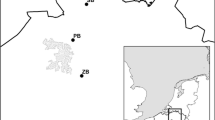Abstract
Critical revision of the terms “pasture (non-nidicole) type of parasitism” and “nest-and-burrow (nidicole) type of parasitism” widespread in the literature forces us to abandon these terms. All the hard ticks are characterized by the same type of parasitism: they belong to a group of temporary ectoparasites with prolonged feeding (Balashov, 2009). By the type of habitat of non-parasitic life stages these parasites can be subdivided into ecological groups of nidobionts (dwellers of nests and burrows) and nemobionts (comprising ticks dwelling outside nests and burrows at non-parasitic life stages).
Similar content being viewed by others

REFERENCES
Balashov, Yu.S. Types of parasitism of acarines and insects on terrestrial vertebrates, Entomol. Rev., 2006, vol. 86, no. 8, p. 957.
Balashov, Yu.S., Parazitizm kleshchei i nasekomykh na nazemnykh pozvonochnykh (Parasitism of Acarines and Insects on Terrestrial Vertebrates), St. Petersburg: Nauka, 2009.
Beklemishev, V.N., On principles of comparative parasitology in relation to bloodsucking arthropods, Med. Parasitol. i Parazitarn. Bolezni, 1945, vol. 14, no. 1, p. 4.
Beklemishev, V.N., Parasitism of arthropods on terrestrial vertebrates. I. Patterns of its formation, Med. Parasitol. i Parazitarn. Bolezni, 1951, vol. 20, no. 2, p. 151; no. 3, p. 233.
Beklemishev, V.N., Parasitism of arthropods on terrestrial vertebrates. II. Main trends of its development, Med. Parasitol. i Parazitarn. Bolezni, 1954, vol. 29, no. 1, p. 3.
Belozerov, V.N., Ecological rhythms in ixodid ticks and their regulation, Parazitol. Sbornik, 1981, vol. 30, p. 22.
Berdyev, A., Types of life schemes in ixodid ticks (Parasitiformes, Ixodidae), Parazitologiya, 1974, vol. 8, no. 3, p. 227.
Berdyev, A.A., Duration of the developmental cycle of Hyalomma asiaticum asiaticum Schulze et Schlottke in natural biotopes, Parazitologiya, 1972, vol. 6, no. 1, p. 30.
Buczek, A., Kubrak, T., Sałata, M., Bartosik, K., Olszewski, T., and Stępień, K., Biological features of non-nidicolous and nidicolous ticks (Acari: Ixodida), in Arthropods. Epidemiological Importance, Lublin: Koliber, 2006, p. 55.
Bychkova, E.I., Fedorova, I.A., and Yakovich, M.M., Iksodovye kleshchi (Ixodidae) v usloviyakh Belarusi (Ixodid Ticks (Ixodidae) in Belarus), Minsk: Belaruskaya Nauka, 2015.
Chaika, S.Yu., Parasitism—existence of organisms as parts of parasitic systems, Parazitologiya,1998, vol. 32, no. 1, p. 3.
Encephalitis.ru, 2019. Code: http://encephalitis.ru
Gray, J.S., Estrada-Peña, A., and Vial, L., Ecology of nidicolous ticks, in Biology of Ticks, vol. 2 (second edition), New York: Oxford University Press, 2014, p. 39.
Klimova, Z.I., Borutsky, E.V., Evseeva, V.E., Medvedev, S.I., Nelzina, E.N., Serzhanov, O.S., and Kharitonov, D.E., Structure of burrow microbiocenoses of the great gerbil in northern Kyzyl Kum Desert. I. Taxonomic and ecological groups of arthropods participating in the formation of microbiocenoses, Parazitologiya, 1970, vol. 4, no. 5, p. 437.
Kocianova, E., Tarageľová, V.R., Harustiaková, D., and Špitalská, E., Seasonal infestation of birds with immature stages of Ixodes ricinus and Ixodes arboricola, Ticks and Tick Borne Diseases, 2017, vol. 8, no. 3, p. 423. http://dx.doi.org/10.1016/j.ttbdis.2017.01.006
Korneev, M.G., Porshakov, A.M., and Yakovlev, S.A., The first finding of ixodid tick Ixodes lividus Koch, 1844 (Ixodidae) in Saratov Province, in Entomologicheskie i parazitologicheskie issledovaniya v Povolzhye (Entomological and Parasitological Studies in Volga Region), 2018, vol. 15, p. 4.
Mal’kova, M.G., Doctoral Dissertation in Biology, Novosibirsk, 2009.
Medvedev, S.G., Adaptation of fleas (Siphonaptera) to parasitism, Parazitologiya, 2017, vol. 51, no. 4, p. 273.
Randolf, S.E., Ecology of non-nidicolous ticks, in Biology of Ticks, vol. 2 (second edition), New York: Oxford University Press, 2014, p. 3.
White, J., Heylen, D.J.A., and Matthysen, E., Adaptive timing of detachment in a tick parasitizing hole-nesting birds, Parasitology, 2012, vol. 139, no. 2, p. 264. https://doi.org/10.1017/S0031182011001806
Yamauchi, A., Theory of evolution of nest parasitism in birds, Am. Nat., 1995, vol. 145, no. 3, p. 13.
Author information
Authors and Affiliations
Corresponding author
Ethics declarations
All applicable international, national, and institutional guidelines for the care and use of animals were followed. All procedures performed in studies involving animals were in accordance with the ethical standards of the institution or practice at which the studies were conducted.
Rights and permissions
About this article
Cite this article
Leonovich, S.A. Types of Parasitism of Hard Ticks (Ixodidae). Entmol. Rev. 100, 1201–1204 (2020). https://doi.org/10.1134/S0013873820080126
Received:
Revised:
Accepted:
Published:
Issue Date:
DOI: https://doi.org/10.1134/S0013873820080126



